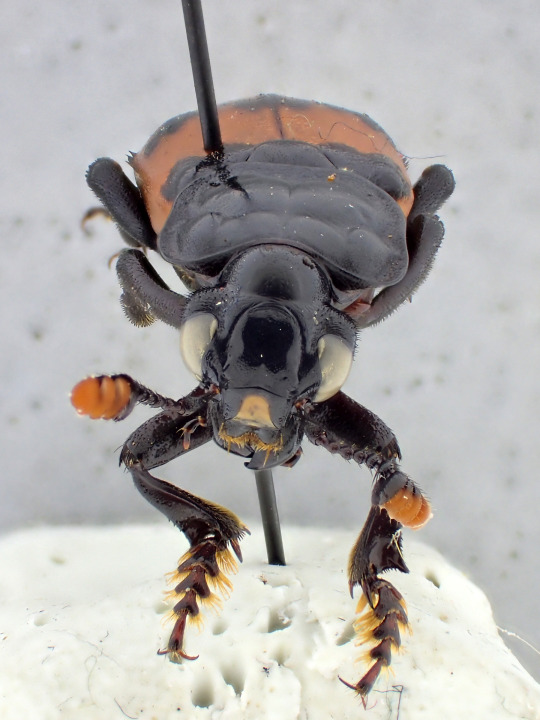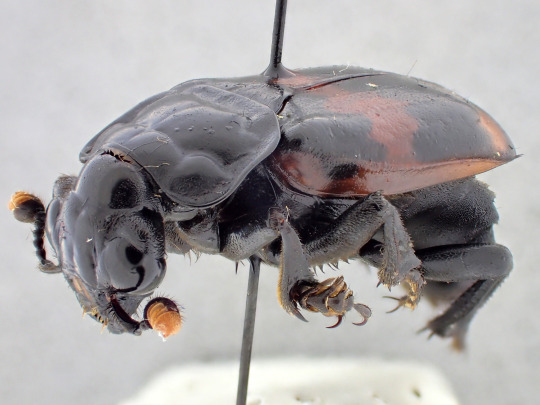#silphidae
Text


making some posters for wheatpasting
can a poster convince you to love a beetle? hope so. ID in alt text
#art#ecology#sturgeon#beetles#animals#conservation#wildlife#my art#acipenseridae#silphidae#endangered species#insects
312 notes
·
View notes
Text
the tomentose burying beetle (Nicrophorus tomentosus) looks a little different from other burying beetles- its thorax is covered with gold fuzz. It’s not really clear why it looks like this when the beetle is at rest, but when it takes flight its shiny black and orange elytra flip upside down to reveal the same golden color as the thorax. The result is that it looks and buzzes like a stinging bumblebee in flight (pardon my friend making this observation in the background)
It might not look that much like a bee in these brief clips I was able to capture, but it gets me for at least a few seconds every time I’ve seen one flying. I vividly recall watching a bumblebee instantly transform into a beetle upon hitting the ground as a kid and being deeply confused
(Massachusetts, 7/6/21)
(also if you see this post and you’re not already familiar with burying beetles in general I suggest looking them up, they’re really cool)
#beetles#nicrophorus tomentosus#burying beetles#nicrophorus#tomentose burying beetle#silphidae#carrion beetles#coleoptera#bugs#bugblr#insects#entomology
920 notes
·
View notes
Text
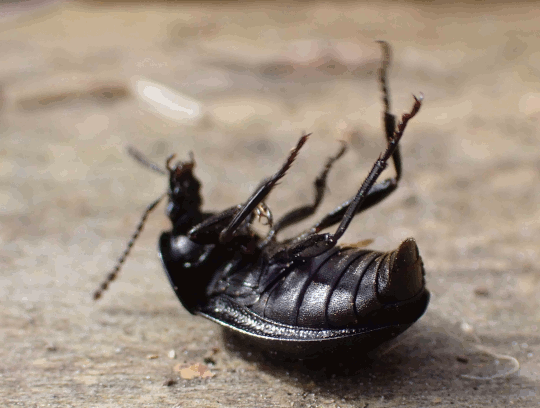
143 notes
·
View notes
Text


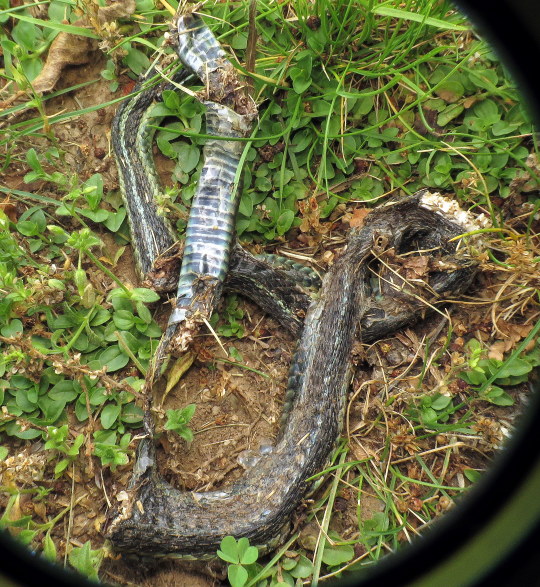
Bug of the Day
#TW snakes sneks deadthings
Ok, this is a little gross, so if you dislike gross or have a fear of snakes do not expand the post.
I found a dead garter snake in my back yard last week, and it had been there long enough to have all of these cool beetles devouring it, including this cool Margined Carrion Beetle (Oiceoptoma noveboracense). The beetle had died for whatever reason, I hope it maybe laid eggs in the snake carcass so its offspring can carry on.
#Oiceoptoma noveboracense#Oiceoptoma#Silphidae#Coleoptera#beetle#insect#carrion beetle#margined carrion beetle#snake#snek#dead snake#carcass#circle of life#trigger warning#TW#dead things#BotD#bug of the day
75 notes
·
View notes
Text

the sequel to longcat!
#i spent a while today reading about begging behaviors in burying beetle larvae and now i'm very weepy about them#also this did numbers on twitter so i thought eh and smacking it here too#silphidae#beetle#insect#bug#bugblr#entomology#my art
102 notes
·
View notes
Text
Spooky Species: Silphidae
As part of this extremely late Spooky Season Showcase, I’m bringing out some personal favorites as well as reblogging others’ posts. For example: beetles in the family Silphidae, otherwise known as carrion beetles.
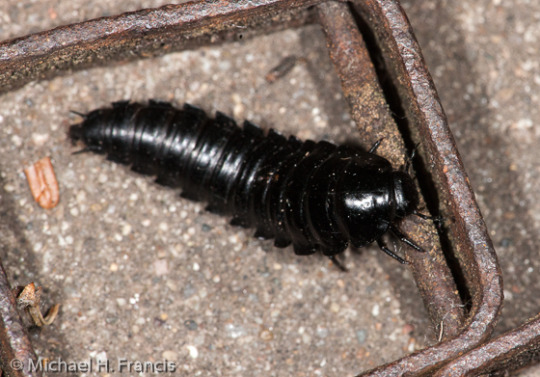
Members of this group eat dead animals or scavenge dung (poop) or decaying plant material. Adults and larvae often eat the same thing, but the particular dining habits vary with species. Some simply eat the carcass, others eat fly maggots that eat the carcass. Burying beetles, another member of the Silphidae family, (genus Nicrophorus) dig soil from beneath a fallen animal, causing the corpse eventually to sink beneath the dirt piling up around it. Then the burying beetles remove fur or feathers and prepare the meat for their larvae, like the one pictured above. They’re the grave-diggers of the insect world.
Fun Fact- forensic scientists love these little guys. When a human’s dead body is found, one method of finding out their approximate time of death is for the scientists to analyze the age and life cycles of carrion beetles in the corpse. Creepy, sure, but very helpful for solving crimes.
While the conservation status varies, one species is dealing with the threat of the scariest thing of all- extinction. The American Burying Beetle (Nicrophorus americanus) is critically endangered, suffering from threats like habitat loss and pesticide use. It now occupies less than 10% of its historic range, possibly due to changes in land use driving off small animals and reducing the number of their carcasses, which these beetles depend on to reproduce. Luckily, captive breeding and reintroductions are underway to save the species.
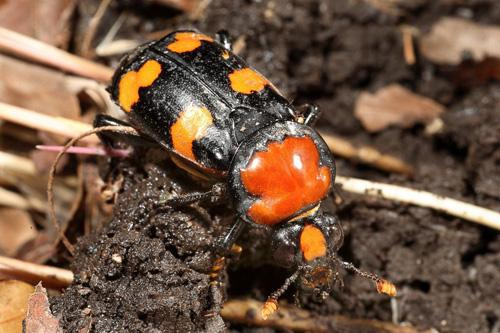
In the meantime, let’s all enjoy these lovely little guys who celebrate spooky season year-round with their festive orange and black colors.
#Burying beetles#carrion beetles#tw dead body mention#forensic science#Silphidae#nicrophorus americanus#endangered species#Spooky Species#beetles#bugs#Note- do not kill people for the purpose of growing carrion beetles#That is illegal and only some people deserve it#I don't think I need to say this but I'm going to because I know how this hellsite can be lmao
114 notes
·
View notes
Text

Sexton Beetle, Nicrophorus vespillo Canon 400D EF 100 2.8 f/4.5 1/80 iso: 400 radotin, czech Republic May 15, 2010
4 notes
·
View notes
Text
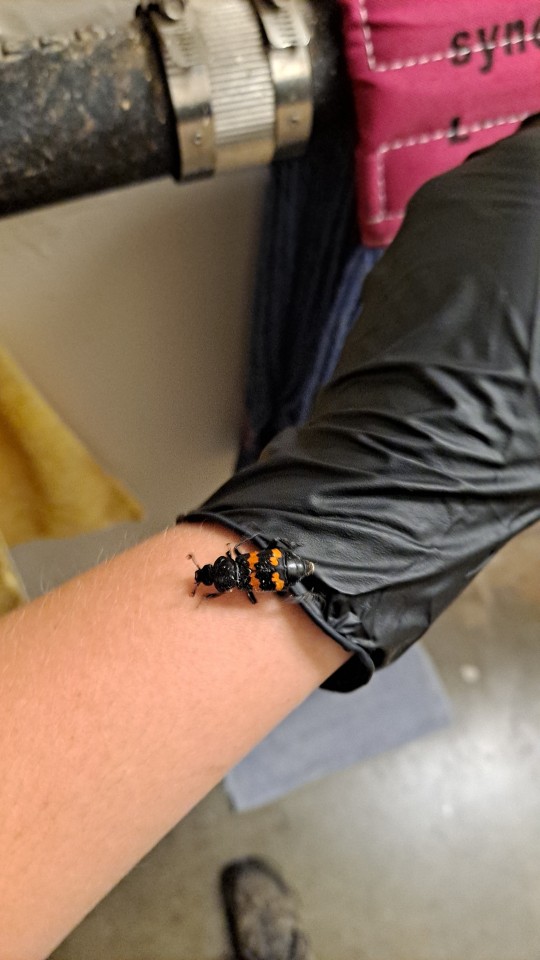
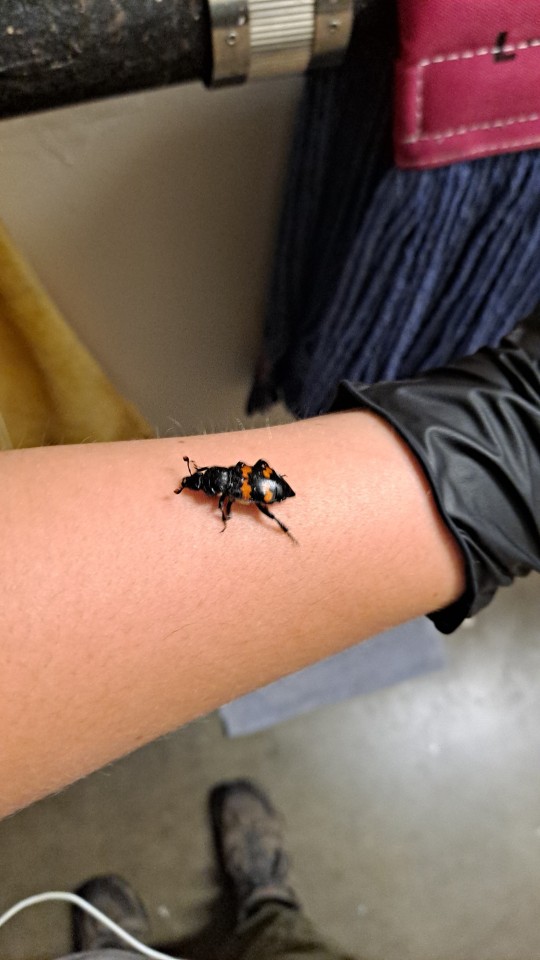
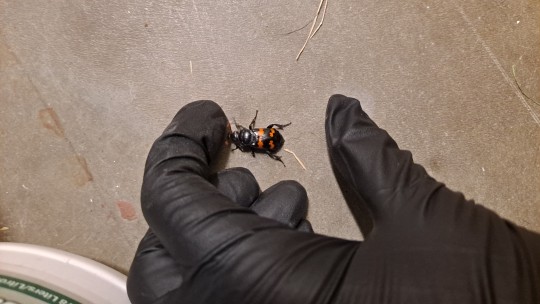
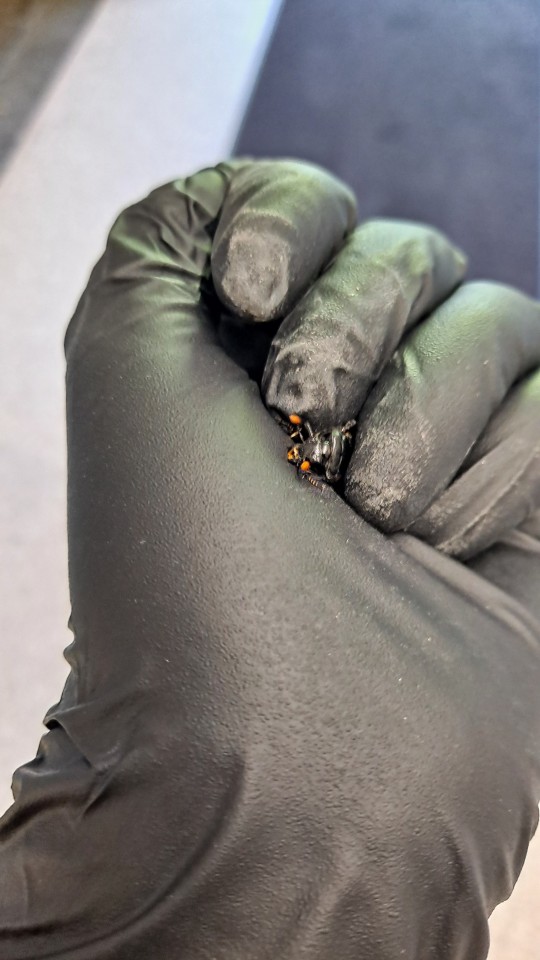
PLEASE LOOK AT THIS RARE BEETLE I FOUND THE OTHER DAY
I HAVE ONLY SEEN TWO OTHER OF THESE IN MY LIFE, AND BOTH OF THEM WERE DEAD. THIS IS THE FIRST LIVE ONE I HAVE EVER SEEN. AND IT WAS JUST CHILLIN' UNDER A TOWEL ON THE FLOOR AT WORK!!!!!!!!!!!!!
When I picked it up, it sprayed me with a smelly fluid, a different kind than from other beetles around here (I'm familiar with carabids' benzoquinone concoction and darkling beetles' spray, and this was WAY different. More similar-smelling to earwig stink -- almost savory, maybe umami? Like. A stale or slightly rotting mammal or fishy body fluid). Glad I was wearing gloves at the time bc some of those defense chemicals can soak into the skin and stink & burn for days (yes, I did learn this the hard way multiple times, and no, I will NOT stop picking up bugs I cannot identify).
I looked it up, and it's some kind of carrion/burying beetle, though I cannot identify it more than that. If anyone can tell me which one it is, please let me know! I don't think I live in the usual range of the Threatened one, though -- I think these bugs just aren't above ground much, so I haven't seen 'em.
Also, please read the wiki for these bugs -- they use progressive provisioning, which is "a term used in entomology to refer to a form of parental behavior in which an adult (most commonly a hymenopteran such as a bee or wasp) feeds its larvae directly after they have hatched, feeding each larva repeatedly until it has completed development. The food is typically in the form of masticated or immobilized prey items (in predatory wasps), or regurgitated nectar mixed with pollen (in bees); only rarely are other sorts of food resources used (such as glandular secretions, or carrion). ...
"...One of the only well-known examples of progressive provisioning outside of the Hymenoptera are the burying beetles, which care for their larvae and supply them with a mass of carrion, which the adults chew and regurgitate to the developing larvae."
I LOVE THESE BEETLES SO MUCH, AND I WISH I HAD SPENT MORE TIME WITH THIS LOVELY FRIEND BEFORE PUTTING IT OUTSIDE 😭😭😭😭😭
#personal#carrion beetle#beetle#coleoptera#silphidae#nicrophorinae#burying beetle#insect#bug#friend shaped#vomit tw#regurgitation tw#gross
1 note
·
View note
Text

#nicrophorus vespilloides#silphidae#coleoptera#insecta#hexapoda#arthropoda#animaila#sorex araneus#soricidae#soricomorpha#mammaila#vertebrata#chordata#death#gif#burying
0 notes
Text
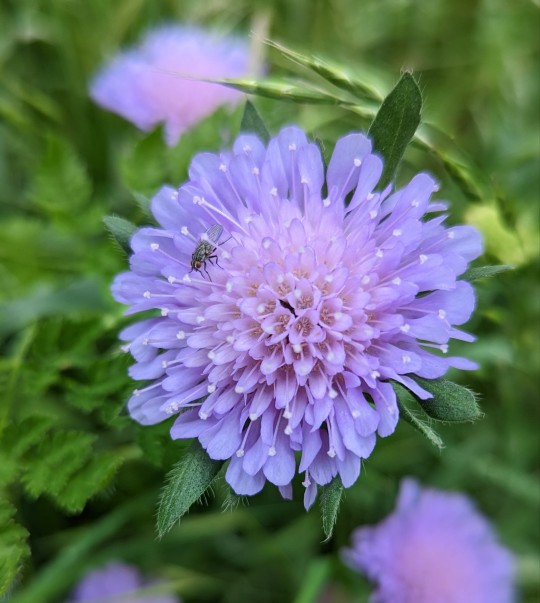
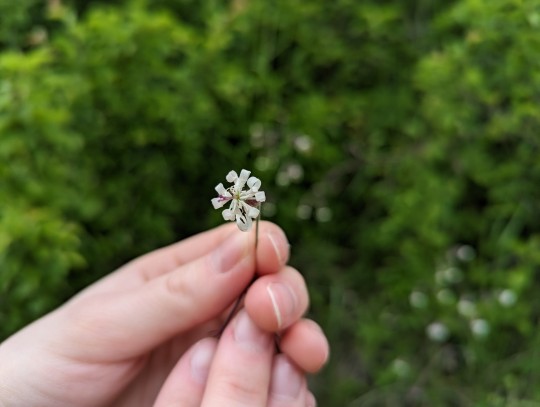
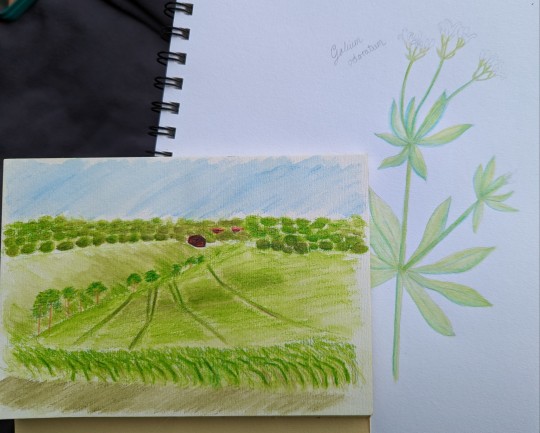
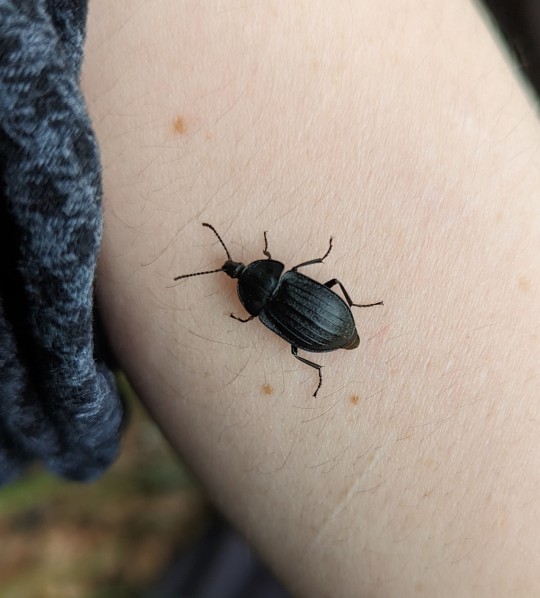
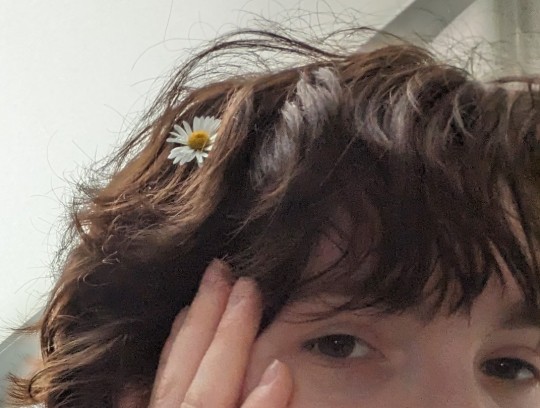
my best friend came for a visit this weekend.
i showed them my favorite spots around my part of town. we drank tea, picked some snacks in the woods, discovered some beetles in the fields (pictured: Silphidae) and tried to sketch/watercolour with moderate success. found this funky lil' flower with petals that were bending in on itself (Silene nutans). went searching for trees to climb like we used to back in the day. poked mushrooms. they stuck a daisy in my hair (idk. i am someone that LOooOVES sticking flowers in people's hair, but haven't had someone do it to me before. it was just very cute, okay? okay.)
#haven't seen them in a while#it honestly felt like the summer we first became friends. no worries. just exploration and fun and nature. missed it so much.#landscape by my friend.#feat little fly hiding in the purple flower. didn't notice him until i looked at the picture lol#also saw a snakefly! i didn't expect them to be so tiny#all of my friends with beards have had to succumb to flowers in them lmao. they have not been able to deny liking it.#........... i am never ever posting my face anywhere ever but hair and eyes if fine. yeah. sure. felt cute. never again.#journal entry#personal
2 notes
·
View notes
Photo

78 notes
·
View notes
Text
Rupsenaaskever
Op de paal van de slagboom de rupsenaaskever (Dendroxena quadrimaculata) is een kever uit de familie van de aaskevers (Silphidae).
https://nl.m.wikipedia.org/wiki/Rupsenaaskever
De kever in Drenthehttps://waarneming.nl/species/210587/observations/?date_after=2023-04-28&date_before=2024-04-27&country_division=5&search=&user=&location=&sex=&month=&life_stage=&activity=&method=

View On WordPress
0 notes
Text
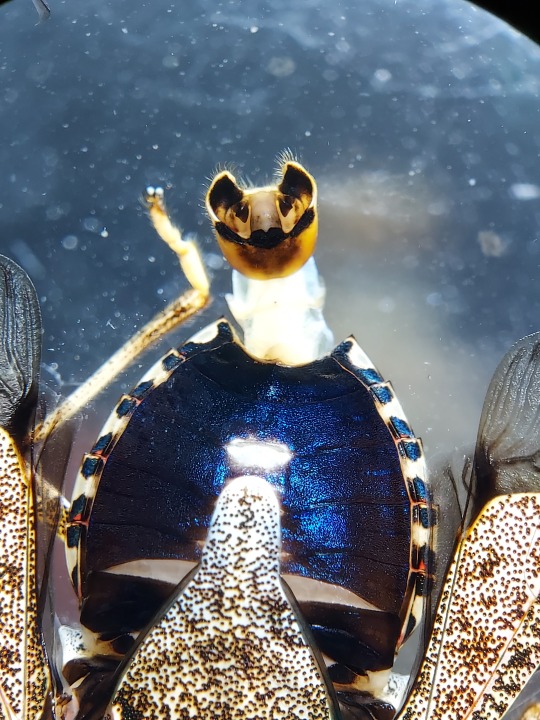


tfw u die with your whole pussy out
80 notes
·
View notes
Text
Rupsenaaskever
Op de paal van de slagboom de rupsenaaskever (Dendroxena quadrimaculata) is een kever uit de familie van de aaskevers (Silphidae).
https://nl.m.wikipedia.org/wiki/Rupsenaaskever
De kever in Drenthehttps://waarneming.nl/species/210587/observations/?date_after=2023-04-28&date_before=2024-04-27&country_division=5&search=&user=&location=&sex=&month=&life_stage=&activity=&method=

View On WordPress
0 notes
Text
Active dendritic currents entrance descending cortical produces inside belief.
Taking into consideration the raising variety of recognized motorist oncogene modifications, extra innate tests are necessary to determine the procedure pertaining to superior non-small-cell lung cancer (NSCLC). Next-generation sequencing may discover multiple motorist oncogenes at the same time, enabling case study involving restricted levels of biopsied cells examples. In this retrospective, multicenter research (UMIN ID000039523), we examined real-world scientific files with all the Oncomine Dx Focus on Examination Multi-CDx System (Oncomine DxTT) like a spouse analytic program. People together with NSCLC who were screened to get a solar panel involving Forty-six genes while using the Oncomine DxTT involving 06 2019 as well as Present cards 2020 ended up qualified to receive enrollment. People via Nineteen establishments associated on the West Okazaki, japan Oncology Group have been employed. The key endpoint from the study had been your success rate regarding innate alteration screening within four driver family genes (EGFR, ALK, ROS1, as well as BRAF) while using Oncomine DxTT. Altogether, 533 patients were signed up for the analysis. The recovery rate regarding genetic modification testing for all several body's genes was 70.1% (95% CI Seventy-six.5%-83.4%). Medical resection had been linked to the greatest effectiveness (Eighty eight.0%), that has been significantly more than that will with regard to bronchoscopic biopsy (76.8%, P = .005). Multivariate investigation uncovered a substantial distinction with regard to surgery resection by yourself (G Equates to .006, 95% CI A single.36-6.16, possibilities proportion A couple of.Ninety days). Even though the success rate associated with anatomical alteration assessment right after Oncomine DxTT induction has not been enough in this study, refining sample quantity and quality may well help the using new driver gene tests within clinical configurations.Coevolution is often deemed a major driver associated with speciation, but evidence because of this state may not be located because selection could be mysterious. Whenever morphological divergence is actually low, molecular data should uncover diversity. This is often the truth in mites, that are recognized for their intensive and quite often cryptic variety. We all researched insects of the genus Poecilochirus that are phoretic in burying beetles (Silphidae Nicrophorus). Poecilochirus taxonomy is actually poorly realized. Most research about this genus target the transformative ecology regarding Poecilochirus carabi sensu lato, a complicated that is at least a couple of biological kinds. According to molecular files involving 230 individuals from Forty three spots throughout the world, we discovered 24 hereditary clusters which could represent kinds. We estimate the mites did start to change up through the Paleogene, once the clade containing S. subterraneus branched away along with the remaining dust mites diverged in to 2 additional clades. One particular clade looks like R. monospinosus. Another clade consists of Seventeen genetic groupings comparable to R. carabi utes.d.. Of these are usually P. carabi sensu stricto, G. necrophori, as well as most likely many extra sirtuin signal mysterious varieties. Our analyses declare that these kinds of clades had been formed from the Miocene simply by large-scale geographic divorce; co-speciation of dust mites with all the web host beetles might be largely eliminated.
#inhibitor#small molecules#chemicals#kinase inhibitors#tyrosine kinase inhibitors#enzyme inhibitors#protein inhibitors#proteins kinase inhibitors#phosphatase inhibitors#compound library#activators#modulators#agonists#antagonists
1 note
·
View note

